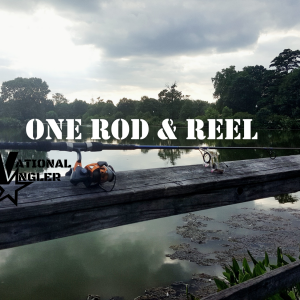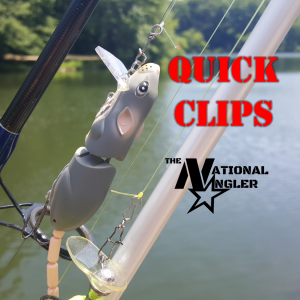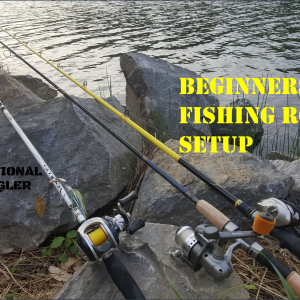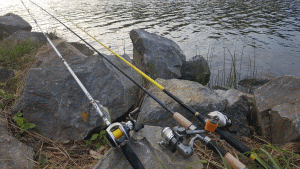I recently wrote an article about keeping things simple with a three-rod setup for bass fishing. Now, this may not be applicable to every type of fishing, but it’s the idea behind which is the goal. One thing when I’m fishing from my buddy’s boat or walking the shore of a local pond I can only bring a couple of rods. However, I always desire to constantly switch baits some days, maybe from a jig to top water. It’s the constant tying of knots that can consume your trip. For me, I usually only go out for a couple of hours, especially when walking local ponds. Well sometimes because I’m rushed, I spend an enormous amount of time changing baits and tying knots over and over.
Take a look at professional bass fishing. The pros in today’s tournament trails carry a crazy amount of rods in their boats already rigged up. Sometimes you will see 15 to 20 rods just on the deck and that’s not including what’s packed away in the rod lockers. To the pros, time is money and even thinking about having to re-tie lures is not acceptable. I’m not a tournament guy, but my time fishing is usually precious time away from the family. I don’t want to waste what little time I do get.
As a kid, I always tried to use a snap swivel, but it just never worked out and it was just too much. Plus it was one extra thing to grab more weeds when I was fishing. It just never made sense for me to use that type of terminal tackle when fishing for something other than maybe catfishing.
Plus, growing up as a kid all I ever wanted to do was be a pro in the Bassmaster tournament trail. Pros don’t use snap swivels on crankbaits, jigs, spinner baits, and finesse baits. Again, when money is on the line a person would not want something to mess up the action of the lure. Tying directly to the lure with various knots seems to be preferred.
Today, after a decade in the military and another to go, I want to keep things simple as possible. The aspirations to become a pro angler have gone, but the desire to fish hasn’t and never will change. My biggest focus is making sure my fishing hobby or addiction doesn’t take away from my family. Today my focus is getting more from my time on the water and being productive and keeping it simple not complex.
Like the pro, I want to take advantage of my time. Instead of carrying dozens of rods already rigged I found a piece of terminal tackle that is new to me, and doesn’t seem to be used by too many people. This simple new piece of tackle has really been a game changer for me.
Quick clips, quick snaps, snap (minus the swivel) or whatever you want to call them are a great opportunity to speed up the process of changing lures and saving time on the water. Now some lures, like a spinnerbait with no defined “eye” with just a bent arm. Well, this piece of terminal tackle will just not work that well. Anything with a defined “eye” and you are good to go! Shockingly I’ve heard before you should always tie directly to the lure because it could take away from the action of the lure. Look at most all crankbaits, even those that are $15+, they all have split rings or snaps on them. Well…guess what…these clips essentially do the exact same thing.
So instead of the terminal tackle on the lure is just on the end of your line, no big deal then! Well, maybe to some really picky technical fisherman this won’t work. For me, this is ideal. It may take away a little action on the lure and cause me to not catch a few fish. I’m really ok with that because this one little piece of terminal tackle does one thing, it gives me more time on the water, with the little time I get. That is the most important part of all this, maximizing your time on the water.
I will say that my fishing partner has got hooked on using these things as well. He only brings two rods with us fishing and now he LOVES these little things. We recently fished the lower Susquehanna River on the northern Chesapeake Bay. We were both swapping out lures to see what was biting. Fish an area, then switch things up, both bass below were as a result of quickly changing lures.
Not all things can be good, and there are a couple of downsides to using these help pieces of terminal tackle. First, they are a little hard to figure out and get used to because of size, and this might cause some distress to those anglers. So the first thing is just getting used to these things, once you do that, you are Go To Go! Second, some eyelets and lure attachments are either too small or just don’t work. I few jigs I tried, didn’t work because the eyelet was too small. Also, a bent arm spinnerbait for example, will also not work because now the clip will slide up and down the arm of the spinnerbait, which is no good. Lastly, and this was kind of a fluke, but I got my brand new $15 Picasso Lures FX Shock Blade wrapped around a try. While pulling on the line to free it, the pressure from being wrapped up must have open the arms of the Norman Speed Clip, and then it happened. In Slooooow motion, my FX Shock Blade floated off the end of the line and plopped in the water, SAD L. Also the Norman speed clips are a little tricky so with big fingers, cold hands or gloves they are difficult. Also to note are baits that require the angler in inpart an action on a lure to make it do something, like a jerkbait, spook, spoon, etc. These baits and do to the jerking motion tended to get hung up between the split ring and the snap. If you want to stick with the snaps on everything you use, some modification will need to be done, like removing the split ring and attaching the snap directly to the eye of the lure.
Over a period of a month I’ve had the opportunity to try other clips that I have found mostly at the local Bass Pro, and this is due to the Quick Shot Snap being sold out and the results have generally been the same with all the competitors
My ultimate recommendation would be to go with the Bass Pro Shops Offshore Angler Quick Shot Snap, has a slight break-in period to loosen up and worked the best for all types of lures. For smaller lures my choice would be the No-Knot Fas-Snap, it is a little smaller but perfect for tiny jigs or flies.
In the end, whatever you want to tie onto or not, is totally up to you! I hope this maybe makes you think of how to help make things more productive on the water the next time that you are out fishing! If you have any questions or comments, I want to hear from you.
Semper Fish!
Joe, The National Angler





